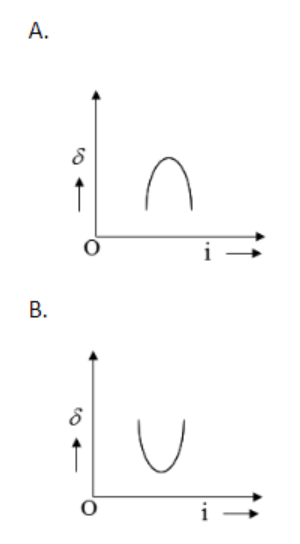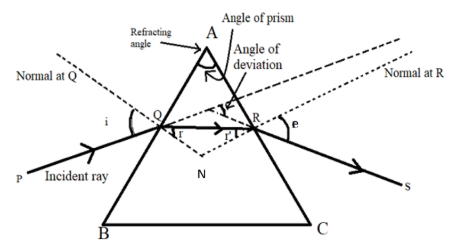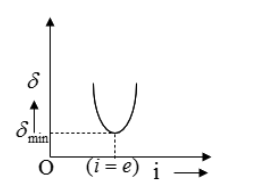
The graph between angle of deviation and angle of incidence (i) for a triangular prism is represented by:




Answer
587.7k+ views
Hint: We can solve this problem with the help of a refraction diagram through the prism. We can find the relation between the angle of deviation and angle of incidence. From this, we can find out the graphical representation of the angle of deviation and angle of incidence.
Complete step by step answer:
A prism is a wedge-shaped portion of a transparent refracting medium bounded by two plane faces inclined to each other at a certain angle. Triangle ABC represents the principle section of the prism. When a ray of light enters from lighter medium to denser medium it bends towards the normal. Here the air is lighter medium and prism is denser medium. As the ray moves out of the prism it again undergoes refraction on moving from denser medium to lighter medium. This time, the refracted ray bends away from the normal.
The angle of deviation \[\delta \] is the angle between the incident ray and emergent ray. It can be understood clearly from the figure.

From the quadrilateral AQNR, the angle Q and R are right angles. Therefore, the sum of the remaining angles of the quadrilateral will be \[180{}^\circ \].
\[\angle A+\angle QNR=180{}^\circ \]
From the triangle QNR, we can say that,
\[r+{r}'+\angle QNR=180{}^\circ \]
We can compare these two equations. So, we will get,
\[r+{r}'+\angle QNR=\angle A+\angle QNR\]
\[r+{r}'=\angle A\]
The total deviation \[\delta \] will be the sum of the deviations at the two surfaces.
\[\delta =(i-r)+(e-{r}')\], where i is the angle of incidence and r is the angle of emission.
Hence, we can write this equation as,
\[\delta =(i+e-\angle A)\]
From this equation, we can say that the angle of deviation depends on the angle of incidence. According to this formula, the plot between the angle of deviation and angle of incidence will be like this.

When the angle of incidence and angle of emergence are equal, then the angle of deviation will be minimum. Thus, it can be called a minimum deviation.
According to the graph, we can say that the correct answer is option B.
Note: The deviation produced by the prism is maximum when either the angle of incidence or angle of emergence is $\text{90}{}^\circ $. This is known as the grazing angle. At this condition, either incident ray or emergent ray will graze along the surface of the prism.
For any other angle of deviations except the angle of minimum deviation, the angle of incidence and angle of emergence can’t be interchanged. That means it has specific values. From the relation between the angle of incidence and angle of deviation, we can say that it is not a linear relationship. So, we can avoid other options.
Complete step by step answer:
A prism is a wedge-shaped portion of a transparent refracting medium bounded by two plane faces inclined to each other at a certain angle. Triangle ABC represents the principle section of the prism. When a ray of light enters from lighter medium to denser medium it bends towards the normal. Here the air is lighter medium and prism is denser medium. As the ray moves out of the prism it again undergoes refraction on moving from denser medium to lighter medium. This time, the refracted ray bends away from the normal.
The angle of deviation \[\delta \] is the angle between the incident ray and emergent ray. It can be understood clearly from the figure.

From the quadrilateral AQNR, the angle Q and R are right angles. Therefore, the sum of the remaining angles of the quadrilateral will be \[180{}^\circ \].
\[\angle A+\angle QNR=180{}^\circ \]
From the triangle QNR, we can say that,
\[r+{r}'+\angle QNR=180{}^\circ \]
We can compare these two equations. So, we will get,
\[r+{r}'+\angle QNR=\angle A+\angle QNR\]
\[r+{r}'=\angle A\]
The total deviation \[\delta \] will be the sum of the deviations at the two surfaces.
\[\delta =(i-r)+(e-{r}')\], where i is the angle of incidence and r is the angle of emission.
Hence, we can write this equation as,
\[\delta =(i+e-\angle A)\]
From this equation, we can say that the angle of deviation depends on the angle of incidence. According to this formula, the plot between the angle of deviation and angle of incidence will be like this.

When the angle of incidence and angle of emergence are equal, then the angle of deviation will be minimum. Thus, it can be called a minimum deviation.
According to the graph, we can say that the correct answer is option B.
Note: The deviation produced by the prism is maximum when either the angle of incidence or angle of emergence is $\text{90}{}^\circ $. This is known as the grazing angle. At this condition, either incident ray or emergent ray will graze along the surface of the prism.
For any other angle of deviations except the angle of minimum deviation, the angle of incidence and angle of emergence can’t be interchanged. That means it has specific values. From the relation between the angle of incidence and angle of deviation, we can say that it is not a linear relationship. So, we can avoid other options.
Recently Updated Pages
A man running at a speed 5 ms is viewed in the side class 12 physics CBSE

The number of solutions in x in 02pi for which sqrt class 12 maths CBSE

State and explain Hardy Weinbergs Principle class 12 biology CBSE

Write any two methods of preparation of phenol Give class 12 chemistry CBSE

Which of the following statements is wrong a Amnion class 12 biology CBSE

Differentiate between action potential and resting class 12 biology CBSE

Trending doubts
What are the major means of transport Explain each class 12 social science CBSE

Which are the Top 10 Largest Countries of the World?

Draw a labelled sketch of the human eye class 12 physics CBSE

How much time does it take to bleed after eating p class 12 biology CBSE

Explain sex determination in humans with line diag class 12 biology CBSE

When was the first election held in India a 194748 class 12 sst CBSE




